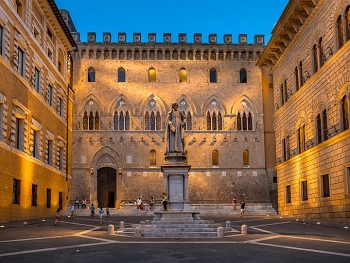How Many Banks Are There in India? Full List of Private, Public & Foreign Banks
 |
| The Banks in India Today |
3 Types of Banks in the Indian Banking System
→ Private sector banks: The majority of the shares in these banks are owned by private companies or individuals.
→ Public sector banks: Institutions that fall under this category of financial institution have the majority of their shares held by the government, or more precisely, by government organizations like the Reserve Bank of India.
→ Foreign bank: In the Indian financial industry, foreign banks conduct business and carry out their functions elsewhere.
Variation Between Private and Public Sector Banks in India
Here are some features that would illuminate the difference between private and public sector banks:
• The shares of public sector banks are owned by the government, whereas private shareholders hold the majority stake in private sector banks
• As a whole, there are 27 public sector banks and 21 private banks, along with four local area banks
• The total market share of public sector banks is 72.9%, whereas the share of private sector banks is 19.7%. Therefore, public sector banks are dominating the Indian Banking system
• Public sector banks have a significantly larger customer base than the private banks
• In public sector banks, there is a lot more transparency in terms of interest rate policies as compared to the private banks
• The interest rates on the deposits done in public sector banks are higher than private sector banks
Check more: Top 10 Biggest Banks in India 2023/2024 - Public and Private Banks
| After gaining independence, India witnessed the rise of numerous banks designed to fulfill the financial needs and ambitions of its people. To better serve these goals, several of these banks transitioned into state ownership. A state-owned bank is one in which the government holds the majority stake and assumes control over its operations. Today, India is home to 12 public sector banks, all of which have undergone this transformation and now operate under government management and regulation. For a detailed breakdown of these state-owned banks, refer to the comprehensive list provided in the article. |
The List of Nationalized Banks
1. SBI and its associate banks
Head office: State Bank of India, Central Office
Chairman’s Secretariat, P.B. No.12, Nariman Point
Mumbai – 400 021
2. Bank of Baroda
Head office: Baroda House, Mandvi
Vadodara – 390006
Gujarat
3. Bank of India
Head office: Express Towers
Nariman Point
Mumbai – 400 021
4. Bank of Maharashtra
Head office: Lok Mangal
1501, Shivaji Nagar, Post Box No. 919
Pune – 411 005
5. Canara Bank
Head office: 112, Jayachamarajendra Road
Post Box No. 6648
Bangalore – 560 002
6. Central Bank of India
Head office: Central Office
Chander Mukhi, Nariman Point
Mumbai – 400 021
7. Indian Overseas Bank
Head office: Central Office
762, Anna Salai, P.B. No. 3765
Chennai – 600 002
8. Indian Bank
Head office: Indian Bank Building
P.B. No. 1384, 31, Rajaji Road
Chennai – 600 001
9. Punjab National Bank
Head office: 7, Bhikaji Cama Place, Africa Avenue
New Delhi – 110 066
10. Union Bank of India
Head office: Union Bank Building
Central Office, 239, Backbay Reclamation
Post Box No. 93A, Nariman Point
Mumbai – 400 021
11. Punjab & Sind Bank
Head office: Bank House
Fourth floor, 21, Rajendra Place
New Delhi – 110 008
12. UCO Bank
Head office: 10, Biplabi Trailokya Maharaj, Sarani
Kolkata – 700 001
13. State Bank of India
Punjab National Bank (With the Merger of Oriental Bank of Commerce and United Bank of India)
♦ Check more: 10 Biggest Banks in the World Today
Why Banks Were Nationalised
There were a number of reasons why banks were taken over by the government. Sometimes, the central government might decide to take over banks. People running for office should know, though, that since liberalization in 1991, governments no longer back nationalization as a policy.
It was Nariman's committee on banking reforms that helped private banks grow in India between 1991 and 1998. The Banking Companies (Acquisition and Transfer of Undertakings) Act of 1970 made it possible for the government to take over banks. The ordinance was put into place on July 19, 1969, in order "to better meet the needs of economic development in line with national policy objectives."
Newer government reports and papers have called for two well-known banks to be taken over by the government. But candidates must know more than just the list of banks that have been taken over by the government. They must also understand why banks are being taken over.
• Financial Inclusion of Masses.
• To promote rapid growth in agriculture, small industries, and export, to encourage new entrepreneurs.
• To Discourage crony capitalisation.
• Ensure prudent lending and better management of banks.
Key Facts - Banks in India
• Allahabad Bank is the oldest Joint Stock Bank in India.
• Andhra Bank was founded by Freedom Fighter Dr. Bhogaraju Pattabhi Sitaramayya
• Bank of India, London, 1946 was the first bank to open a branch outside India.
• The first bank to be given an ISO 9002 certificate for one of its branches — Canara Bank
• The Postal Dept has issued a commemorative stamp in the name of this bank celebrating 100 years in 2011 — Central Bank of India
• First Indian Bank to be wholly owned by Indians — Central Bank of India
• The bank was formed on the efforts of Lala Lajpat Rai — Punjab National Bank
• The only merger of nationalized banks took place between — Punjab National Bank and New Bank of India in 1993
• The bank whose brand equity is “Pygmy Deposit Scheme” — Syndicate Bank
• The bank which was conceived by Shri GD Birla — UCO Bank
• The bank which was inaugurated by Mahatma Gandhi in 1919 — Union Bank of India
• The largest among nationalized banks — Punjab National Bank
• The State Bank of Mysore's banking committee, which was led by the legendary engineer-statesman Dr. Sir M. Visvesvaraya, decided to establish the bank in 1913 under the name Bank of Mysore Ltd.
What are Government Banks
Government banks are another name for public sector banks, which are also called PSBs. It's the biggest shareholder in these companies, even though the government doesn't directly run the government banks. It owns more than 51% of the shares. These are also called "government banks," and there are 12 of them in India.
Payment Banks In IndiaPayments banks were meant to be an alternative to India's traditional banks, but they can't give out loans. These banks can take restricted deposits up to a limit of Rs. 200,000 per customer, which could go up in the future. Payment banks aren't allowed to give out loans or credit cards. You can open a savings account or a checking account at these banks. |
Private Indian Banks
What are private sector banks?
These are the banks where private individuals continue to hold a significant portion of the equity or shares. Private sector banks emerged in the 1990s and have seen tremendous growth since then, but initially public sector banks predominated the Indian banking sector.
Utilizing cutting-edge technology, novel financial instruments, and contemporary innovations led to their rapid expansion.
In India, private sector banks are classified into two divisions
• Old Private sector banks (these banks emerged before 1968)
• New Private sector banks (these banks emerged after the 1990s)
A specific type of bank in India is called a private bank, in which a small number of private businesses or people control or own the vast majority of the stock. They are mainly concerned with advancing the interests of an individual or group other than the government. In this article, we discussed Indian private banks and how they differed from public sector banks.
Most of the stakes in private Indian banks are owned by private people. This article has a list of these institutions to help you understand what private Indian banks are and how they work.
By wisely allocating resources, the financial framework makes a big difference in the growth of the currency. It is good for the economy because it turns your savings into businesses that make money. The Reserve Bank of India, which is the central bank of the country, keeps an eye on the banks. It is India's most important financial oversight body. In India, banks are split into several groups, each with its own organizational structure, target industries, pros and cons.
FAQs
How many nationlaised banks are in India?
As of present, there are 12 nationalized banks in India.
What are nationalised banks?
The nationalized banks are those banks that were ones owned by the private players but due to the financial or socio-economic exigencies, the ownership was acquired by the government. In more technical terms Nationalised Banks have such an ownership structure where the government is the majority shareholder i.e. >50%.
Who is the over all regulator of banking systen in India?
Reserve Bank of India or RBI is the overall regulator of banking system in India.
Which is the best governement bank in India?
State Bank of India is widely regarded as the best government bank in India.
How many private banks are there in India?
Answer. There are 21 private banks in India as of 2022.
List the top 3 private banks according to revenue in the Indian banking system?
Answer. List of top 3 private banks according to revenue in the Indian banking system:
- HDFC bank – 105,161 Cr
- ICICI bank – 84,353 Cr
- AXIS bank – 56,044 Cr
Which is the number one private bank in India based on turnover?
Answer. ICICI is the main and number 1 private bank in India. It has the most noteworthy turnover of Rs.101,561 Cr the earlier year.
What is the distinction between public and private sector banks in India?
In private sector banks, on the other hand, the stockholders of the bank hold the majority of the shares, as opposed to the government in public sector banks. While private sector banks are renowned for their competitive outlook and technological superiority, public sector banks are known for their organizational structure and larger customer base.
 10 Oldest Surviving Banks In The World 10 Oldest Surviving Banks In The World Banking has been a part of life since the early days of human civilization. What is the first bank in the world? |
 Top 10 Best Saving Accounts and Rates in the U.S Top 10 Best Saving Accounts and Rates in the U.S Which bank in USA gives highest interest on saving accounts & rates. We ranked the top 10 US banks with the best savings account interest ... |
 Top 10 Biggest Banks in the US 2023/2024 by Total Assets Top 10 Biggest Banks in the US 2023/2024 by Total Assets Everyday, the banking system plays a significant role in every American's life. But have you ever wondered which banks in America are the biggest? |























